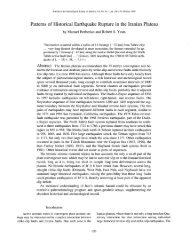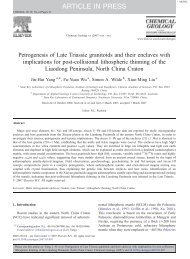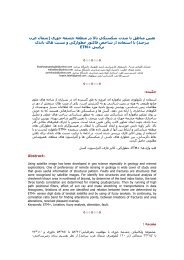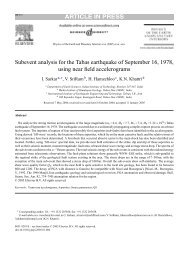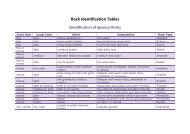Reduced Intrusion-Related Gold System - GSINET | Geological ...
Reduced Intrusion-Related Gold System - GSINET | Geological ...
Reduced Intrusion-Related Gold System - GSINET | Geological ...
You also want an ePaper? Increase the reach of your titles
YUMPU automatically turns print PDFs into web optimized ePapers that Google loves.
C.J.R. Hart<br />
A<br />
B<br />
FIGURE 7. (A) Outcrop-scale exposure of an array of intrusion-hosted,<br />
sheeted quartz veins in the apex of the Rhosgobel pluton at Clear Creek,<br />
Yukon. One- to three-cm-wide veins of simple, single-stage quartz with<br />
minor sulphides and scheelite fill parallel, extensional fractures that<br />
may extend for hundreds of metres. Individual veins may contain 50<br />
g/t Au, but host rocks are barren such that vein density is the gradecontrolling<br />
feature. Wide intersections generally average 1 g/t Au. Note<br />
14 cm-long marker pen (circled in red) for scale. (B) Ore from Fort<br />
Knox i s dominated by a series of subparallel, white and grey, singlestage<br />
quartz-sulphide veins that are parallel with the east–west elongate<br />
direction of the pluton, and other structural elements such as dikes and<br />
shears (in this photo, the veins are offset by a small fracture). It should<br />
be noted that there are not interconnected, multidirectional quartz vein<br />
stockworks that are typical of porphyry deposits. Alteration, mainly<br />
sericite-calcite, is limited to the immediate vein selvages.<br />
many authors, including Maloof et al. (2001), Marsh et al.<br />
(2003), and Mair et al. (2006b).<br />
Early ore stages are dominated by high-temperature<br />
(650°C) anhydrous diopsidic pyroxene-plagioclase skarns<br />
that locally contain scheelite. Lower-temperature (420°C),<br />
and sometimes overprinting, hydrous, either biotite-, zoisite-<br />
, or actinolite-dominant skarn assemblages may be Au-bearing<br />
where they contain significant amounts of sulphide minerals.<br />
High-temperature sulphide assemblages are dominated<br />
by pyrrhotite>>chalcopyrite, but lower-temperature assemblages<br />
are dominated by arsenopyrite with various Bi-Te-Sb-<br />
Pb-Au minerals and alloys (Fig. 10). All silicate assemblages<br />
lack garnet, which is a feature of reduced skarns (Meinert,<br />
1998).<br />
Early veins are dominantly intrusion-hosted and are characterized<br />
by alkali feldspar-, mica-, and scheelite-bearing<br />
quartz veins that may host only sparse sulphide minerals and<br />
may lack Au. Slightly lower-temperature, sheeted vein arrays<br />
are similar but may host up to a few percent pyrite or arsenopyrite,<br />
but with blebs of various Au-Bi-Te alloys, and are the<br />
key hosts to Au mineralization. At the system scale, and more<br />
commonly outside of the intrusion, are more sulphide-rich<br />
arsenopyrite and antimony veins. The last gasps of the hydrothermal<br />
event generate Ag-Pb-Zn-bearing quartz veins which<br />
occur in the most distal locations, often beyond the limits of<br />
the hornfelsed aureole. These distal Ag-rich galena-sphalerite<br />
quartz-carbonate veins also form the 30 km-long Keno Hill<br />
Ag district and may indicate a regional zoning within the<br />
Tombstone <strong>Gold</strong> Belt.<br />
The mineralogy of intrusion-hosted sheeted veins, such<br />
as those at Dublin Gulch and Fort Knox, comprise a single<br />
stage of massive, translucent grey or white quartz, locally<br />
with subordinate coarse-grained, white K-feldspar or mica<br />
that are most commonly on the vein margins. Some veins are<br />
“dry”, lacking quartz, and consist of sulphide mineral-coated<br />
fractures with biotite, which form a limonitic gouge where<br />
oxidized. Low sulphide contents (0.1%–2%) typify intrusionhosted<br />
assemblages, which are dominated by pyrite > pyrrhotite<br />
> arsenopyrite with accessory scheelite and bismuthinite.<br />
Arsenopyrite is much more abundant in country rock-hosted<br />
veins (up to 10 vol.%), and is common with pyrrhotite in replacement-style<br />
mineralization. Accessory molybdenite occurs<br />
locally in thin quartz veins; chalcopyrite, sphalerite, and<br />
galena are sparse. Cassiterite has been reported near some occurrences<br />
(e.g., Tin Dome at Dublin Gulch) but is rare and<br />
does not occur with Au.<br />
Native Bi and Bi-bearing sulphosalt minerals are commonly<br />
described from various mineralization styles in RIRGS.<br />
They occur late in the paragenesis and are typically alloyed<br />
with Te, Pb, Sb, or Au. Tellurobismutite, maldonite, tetradymite,<br />
native Bi, boulangerite, and Bi-Pb sulphosalts have<br />
been recognized at Fort Knox (McCoy et al., 1997, 2002).<br />
At Dublin Gulch, approximately 40% of the Au occurs as<br />
complex intergrowths with native Bi (Hitchins and Orssich,<br />
1995), but Au also occurs in Bi-Pb sulphosalts with galena<br />
and molybdenite (Maloof et al., 2001), and with bismuthinite,<br />
tetradymite, tellurobismuthite (Hitchins and Orssich, 1995).<br />
The common association of very high fineness free Au within<br />
or adjacent to native Bi or bismuth-bearing minerals suggests<br />
that Au may have exsolved from earlier, high-temperature Bialloys,<br />
upon cooling (Fig. 10).<br />
Ore mineralogy at the epizonal Brewery Creek deposit is<br />
distinctly different but relatively simple. It is dominated by<br />
early pyrite, with associated arsenian pyrite and arsenopyrite<br />
(Diment and Craig, 1999; Lindsay et al., 2000). Oxidized<br />
mineralization appears disseminated with limonite, but hypogene<br />
ore shows sulphide minerals in, and adjacent to, spaced,<br />
sulphidized fractures lacking quartz. <strong>Gold</strong> is refractory, being<br />
associated with acicular arsenopyrite and the arsenian pyrite<br />
overgrowths on early pyrite. Although late stibnite veins are<br />
also a common feature, their association with Au is equivocal.<br />
102



